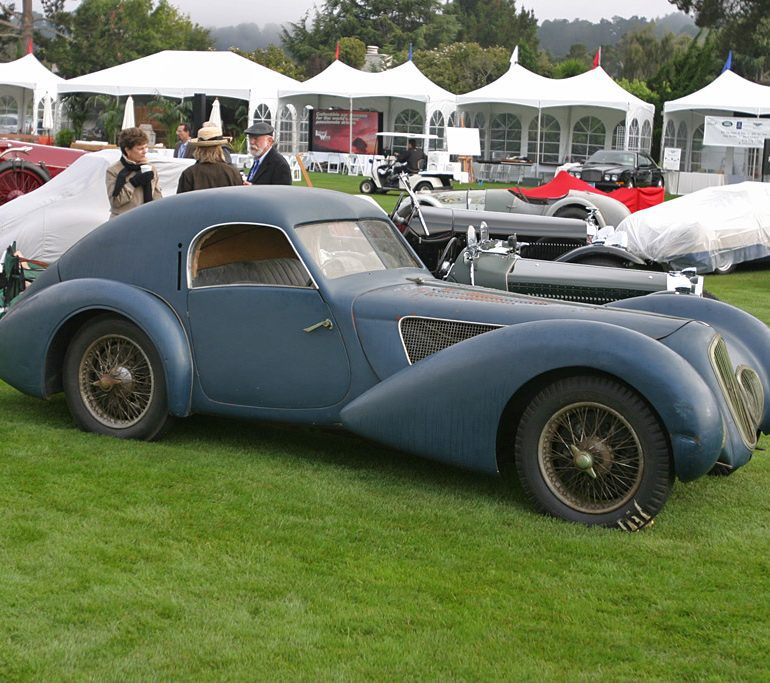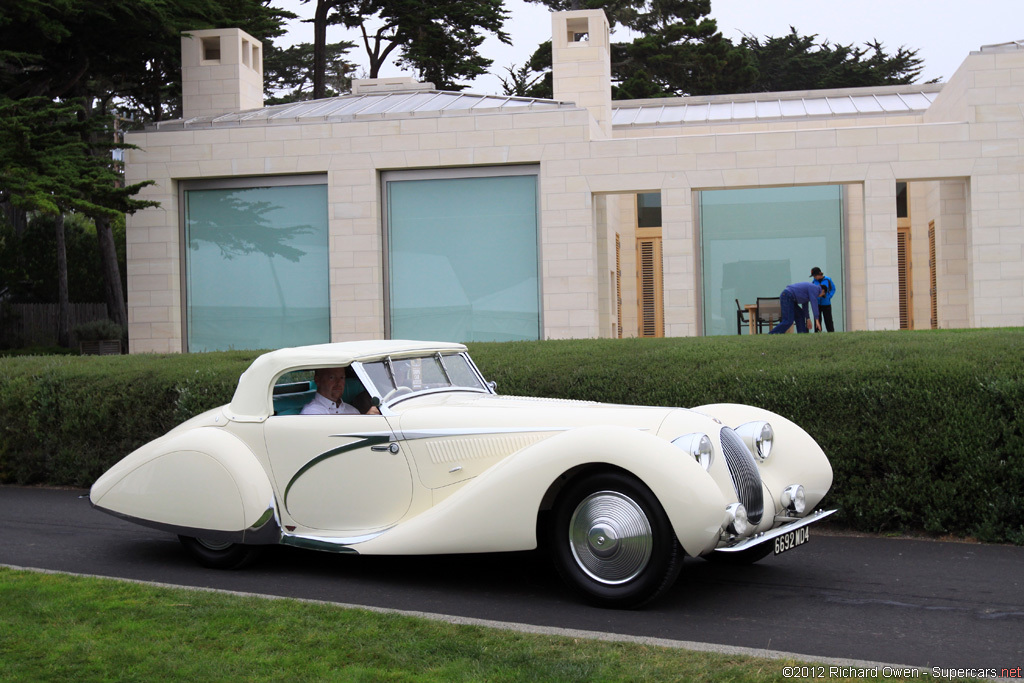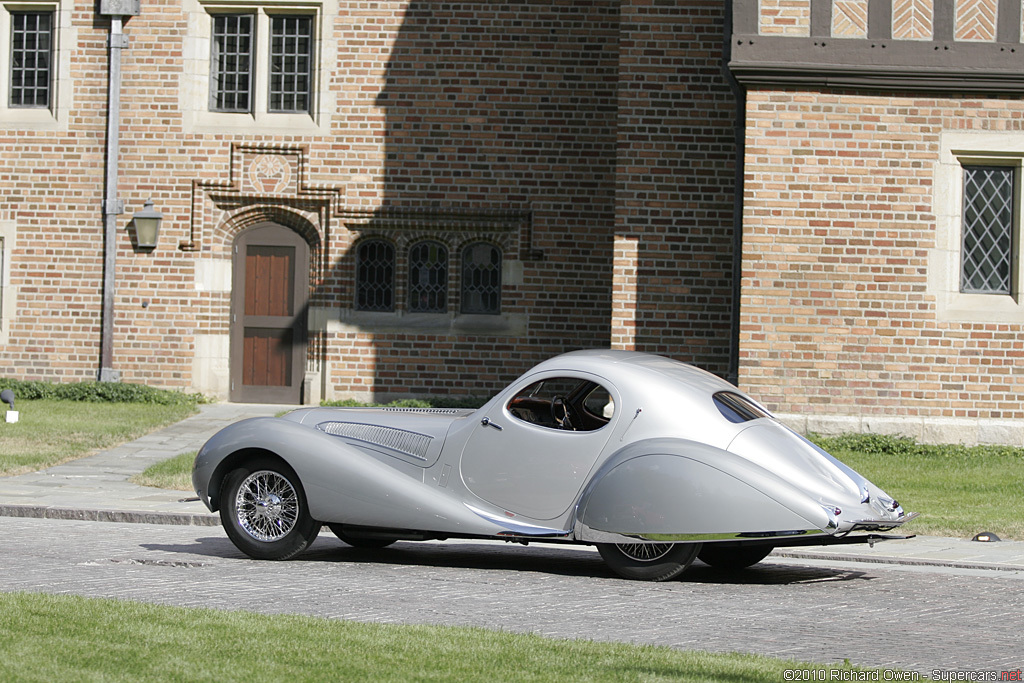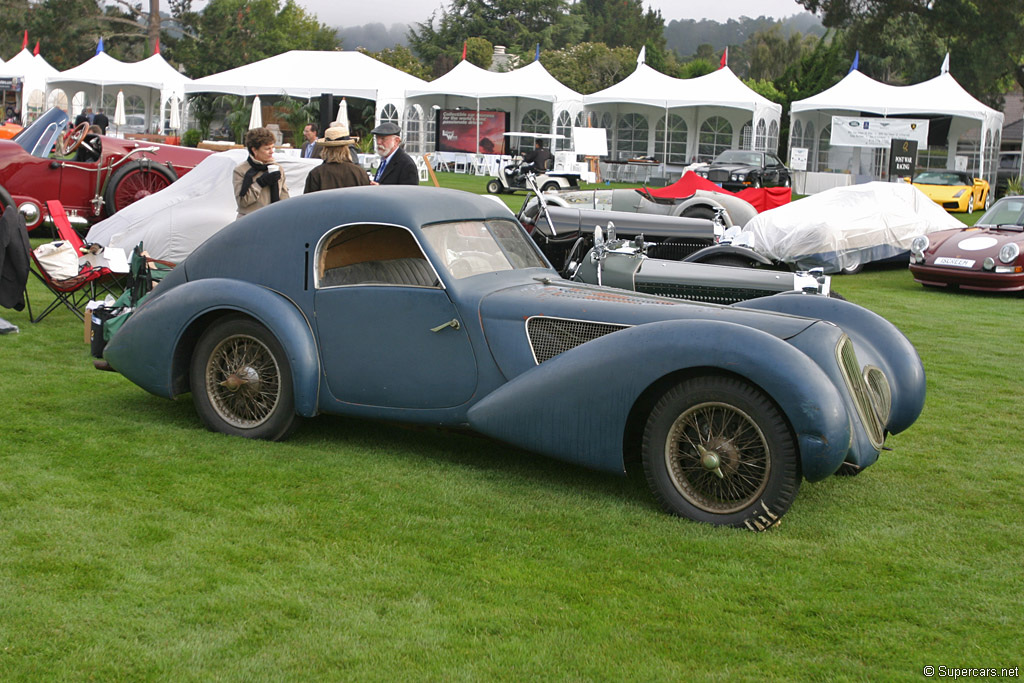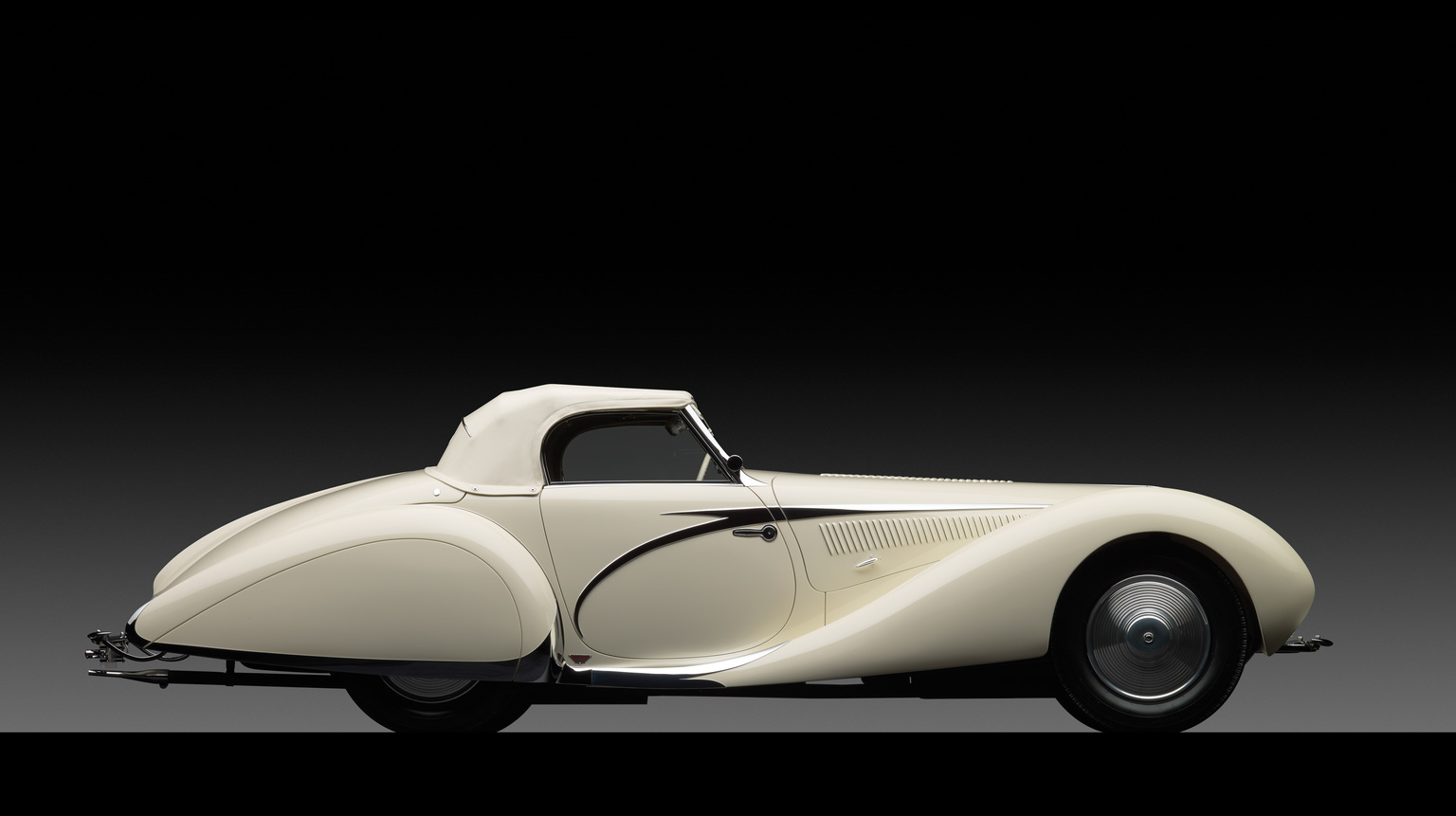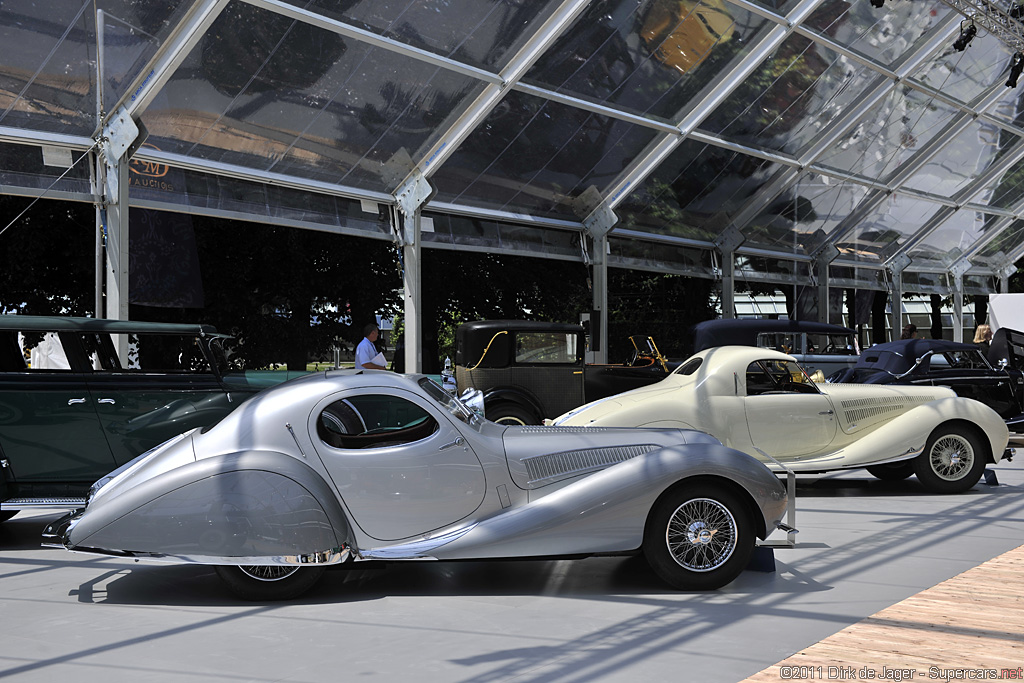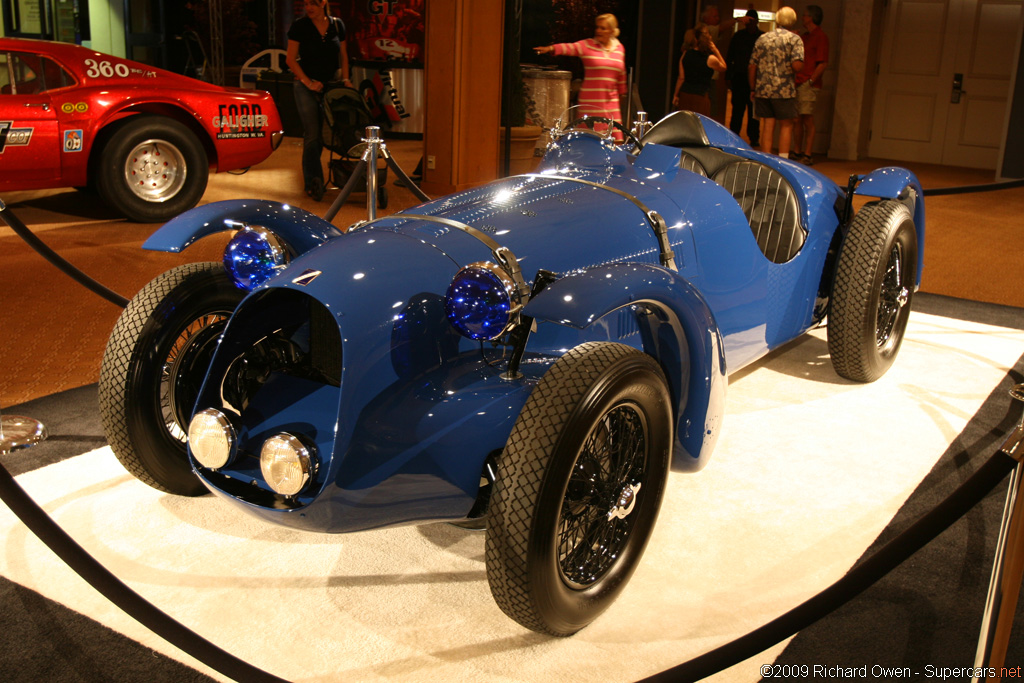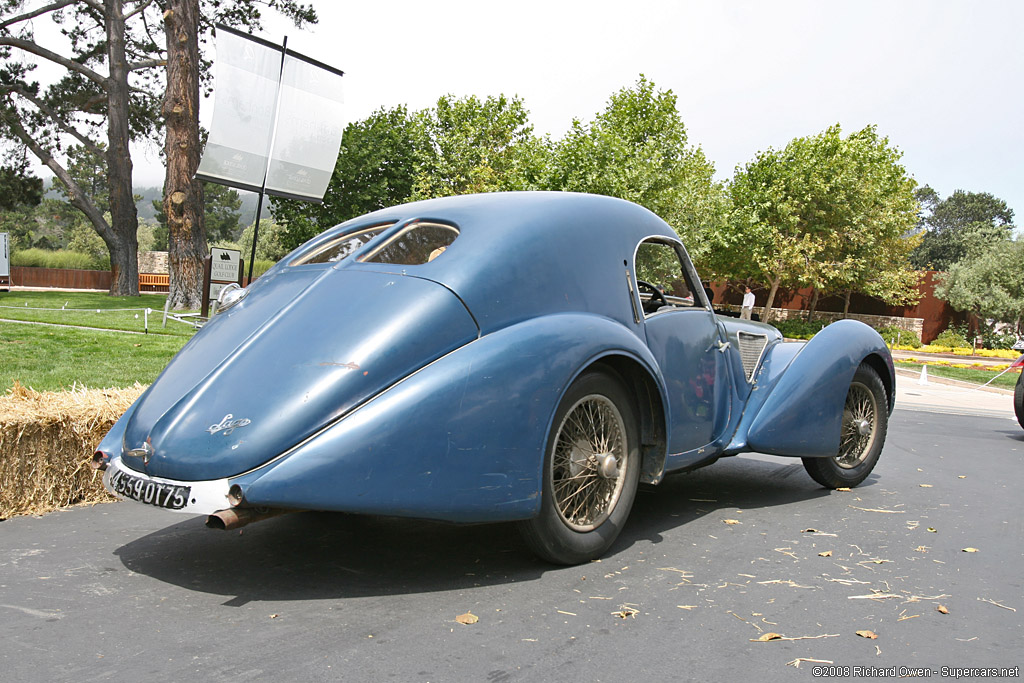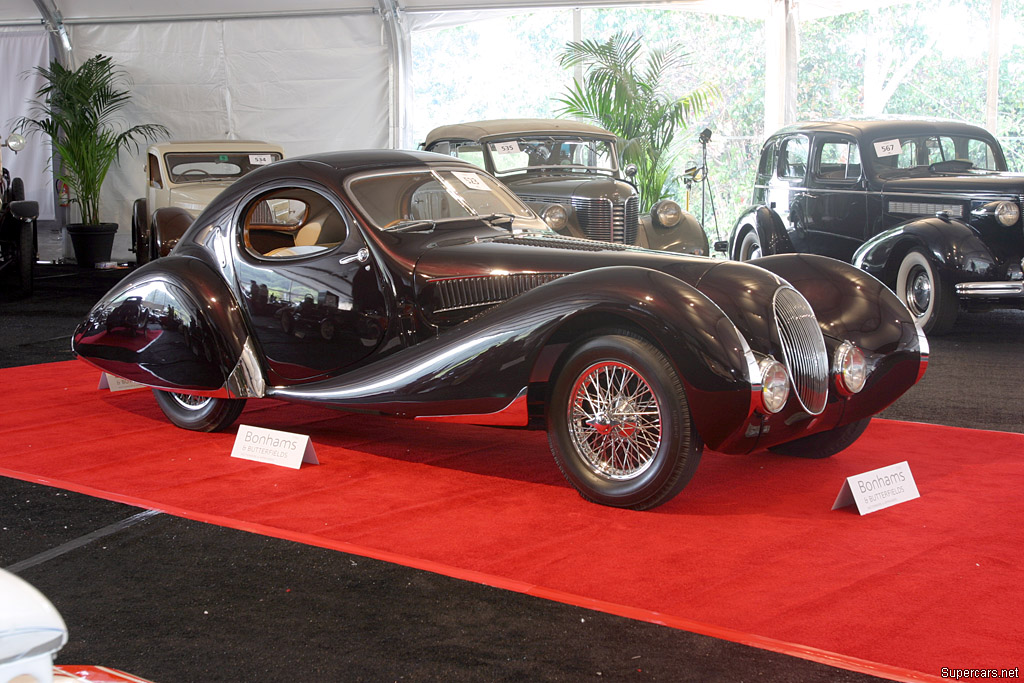1937 Talbot-Lago T150C SS
Of all the cars available in in the art deco era, the T150C was almost always transformed into rolling sculpture. Most of the cars were bodied by Figoni et Falaschi into some of the most voluptuous shapes sometimes referred to as the ‘Goutte d’Eau’ or teardrop.
During its era, the teardrop, also known as the ‘Goutte d’Eau’, was one of the select few automobiles that both redefined automotive style and won top-level races. Having successfully combined racing function and elegant form, the Teardrop became trend setting and motivated many other French manufacturers to consider more streamlined design.
While all of the French coach builders contributed to the styling ‘renaissance’ of the thirties, none did so quite much as Italian-born Giuseppe Figoni. He teamed with businessman Ovidio Falaschi to create one of the most prolific and successful French design companies: Figoni et Falaschi.
The Teardrop was Figoni et Falaschi’s most coveted work. It was, in a sense, a revolt against the more functional cars from the twenties. Here was a design devoid of any straight lines, one decorated with sensual curves which advertised speed without even moving. This style was emphasized by the diminishing pontoon fenders, called ‘enveloppantes’ by Figoni, and a converging rear end that could be called a fastback.
Figoni’s flowing designs were first seen in 1935 and on the Delahaye 135 chassis. These were a direct response to the Mercedes-Benz 540 K Autobahnkurier launched a year earlier at the 1934 Frankfurt Motor Show. By 1937, the Talbot Teardrop became the ultimate expression of this streamlined era and made its seminal mark in Paris as well as the 1937 New York Auto Show.
Throughout production Figoni played with the design, creating some roadster versions and other variations on different chassis. Pourtout was commissioned to built at least two teardrop coupes which were different in detail from the Figoni body.
T150C Chassis & Racing
With its independent front suspension, lightweight construction, excellent braking and low ride height the T150C chassis was focused on competition. It also benefited from Talbot’s rich heritage in motor sport and included engineering similar to the Talbot which won the 1937 French Grand Prix. The definitive version of the T150 was the shortened and lighter SS chassis which the New York Style Teardrops were built upon.
Before creating his vision of a supercar, engineer Antonio Franco Lago traveled to England in the 1920s. There, he eventually found investors willing to offer the capital needed to purchase his needed licenses. The first of these was a Wilson pre-selector gearbox which was complex, but allowed the driver to select the next gear in advance and then simply dab the clutch. Armed with this transmission and a suspension design from Sunbeam-Talbot-Darracq Antonio moved back to France on a mission.
Working with engineer Walter Brecchia, Lago turned the Talbot T120 into the Talbot-Lago T150. The transformation included a new cylinder head with hemispherical combustion chambers and the Wilson gearbox. Immediately the sporting pedegree of the T150 was apparent and a 3-liter car contested LeMans in 1935 but retired. The following year the engine was increased to four litres to match 1936 regulations. Unfortunately, the larger car didn’t achieve any sales success or race success.
In 1937 Lago announced the T150C, a lightweight variant of the old chassis that stood for course or competition. These won the Tunisia, Montlhèry race as well as the British Tourist Trophy. Later in the year, Talbot released his road-going versions. The first of these was named SS after the American term Super Sport. They had a short wheelbase of 2.65m. A longer 2.95m variant was offered called Lago Speciale and was generally meant for more luxurious bodies. By 1937, Figoni et Falaschi had struck a deal with Talbot-Lago to create teardrop bodies for both versions of their chassis.
The first Teardrop was shown in August of 1937 at the Paris-Nice Criterium de Tourism. Featuring the 4-litre engine and shortened version of the competition chassis the completed car was good for 100 mph.
Remarkably, one showroom stock Teardrop raced and placed third overall at the 1938 24 Hours of LeMans. The following year 90117, a specially prepared T150C SS featuring aluminum bodywork, an outside fuel filler and other special components, raced under Luigi Chinetti, but retired on the 88th lap. These Lemans cars were followed up by a another car won its class at the 1948 24 Hours of SPA. During these races, the Talbots faced stiff competition from Alfa Romeo and Bugatti.
In Detail
| submitted by | Richard Owen |
| type | Series Production Car |
| coachbuilder | Figoni et Falaschi |
| production | 11 |
| engine | Inline-6 w/Hemispherical Combustion Chambers |
| position | Front Longitudinal |
| aspiration | Natural |
| valvetrain | Pushrod OHV, 2 Valves per Cyl |
| fuel feed | Tripple Stromberg Carburetors |
| displacement | 3996 cc / 243.85 in³ |
| compression | 7.4:1 |
| power | 104.4 kw / 140.0 bhp @ 4200 rpm |
| specific output | 35.04 bhp per litre |
| bhp/weight | 93.52 bhp per tonne |
| driven wheels | Front Engine / RWD |
| front tires | 600×17 |
| rear tires | 600×17 |
| front brakes | Drums |
| rear brakes | Drums |
| steering | Worm & Nut |
| f suspension | Independant w/Transverse Leaf Springs |
| r suspension | Live Axle w/Leaf Springs |
| curb weight | 1497 kg / 3300 lbs |
| wheelbase | 2650 mm / 104.3 in |
| front track | 1372 mm / 54.0 in |
| rear track | 1461 mm / 57.5 in |
| transmission | Wilson Four-speed Pre-Selecto |
| final drive | 4.1:1 |
| top speed | ~185.1 kph / 115.0 mph |
Auction Sales History
1936 Talbot Lago T150C Figoni & Falaschi Cabriolet 90111 – sold for $7,150,000 From the collection of James Patterson comes this 1936 Talbot Lago T150C Cabriolet by Figoni & Falaschi, chassis number 90111. This car won its class at the 2012 Pebble Beach Concours d’Elegance following an exacting restoration by RM Auctions.
Auction Source: RM’s Art of the Automobile
1938 Talbot-Lago T150-C SS Teardrop Coupé 90112 – sold for €3,136,000 A triple award winner at Pebble Beach in 2009 and Best of Show at Meadow Brook in 2010. Shown at concours events in period. Show-quality restoration by RM Auto Restoration. One of only 11 examples with Second-Series “New York” Figoni coachwork. Rare Factory sunroof. Sophisticated race-bred, short-wheelbase T150-C SS Talbot-Lago chassis.
Auction Source: RM 2011 Villa d’Este Auction
1938 Talbot-Lago T150 C SS Teardrop Roadster – did not sell for $1,200,000
In the world of important French cars, provenance is second only to design, and 900115 stands with the best of the Teardrops, having a continuous history from new, a commendable and unique competition record, and no history of fire, accident, or deterioration. Although its coachwork has taken two forms, the Grand Prix racing coachwork it still wears today was installed new for its second owner. Furthermore, all the car’s major components remain intact and together even now, so many years later.
Delivery took place in 1938, shortly before the Nazi invasion of France, and as has already been noted, the car’s first owner was a Parisian gentleman, M. Cattino. Although we know the legendary Louis Rosier was the next owner, the date of the sale is not known. Naturally, all motor racing ceased with the advent of hostilities, and the car must have been hidden for the duration. It seems likely that Rosier purchased the car after the war as it was in 1946 that he began driving the car when motor racing resumed following the war. Still wearing its Figoni coachwork, Rosier simply removed the wings and windscreen and effected other small changes in order to make it more suitable for competition.
Later, in 1947, Rosier had new Grand Prix coachwork fabricated and installed, reportedly by the Talbot factory. This is the coachwork that remains with the car today. Upon close examination, the cowl structure is identical to that of the other T150C chassis, indicating that the Figoni body may not have been removed and discarded, but rather re-skinned and rebuilt into its new form.
During 1946 and 1947 Rosier actively campaigned s/n 90115, as the accompanying chart indicates. He finished most often in the top six, with a handful of first place finishes during the period, including an overall win at the Grand Prix of Albi, and a fourth place finish at the Grand Prix du France.
In 1948 Rosier took delivery of a new Talbot-Lago T26 and sold 90115 to Charles Huc, who raced the car in 1948 and 1949. In 1950 the car was in the hands of M. Fayen, who raced it several times in 1951 and 1952 before selling it to M. Leroy of Le Havre, France. It was here that something happened that would confound historians for more than fifty years. While s/n 90115 was in Leroy’s garage, so too was s/n 90111, its sister car, still wearing its Figoni roadster coachwork. For reasons long forgotten, Leroy switched the chassis plates between the two cars. The most likely explanation is that one car had duties and taxes paid, while the other didn’t – but for whatever reason the tags would remain reversed until 2009, when a consensus of historians and the two owners agreed on what had happened, and furthermore, agreed to set things right by returning the tags to their proper chassis. Forevermore, however, it will require historians to remember this period when many books and articles were published while the tags were reversed, and therefore the identities were also confused.
Aside from the historical evidence, there were two important pieces of documentation that finally, after more than 50 years, confirmed that the tags were reversed. The first was the original vehicle registration log from Marseilles, which identified s/n 115 as belonging to Louis Rosier, and carrying plate 7413CB, which is clearly visible in one of the photos of Rosier’s car. Finally, the second car, which still carries its original Figoni coachwork, is stamped as Figoni body #661. According to Claude Figoni’s records, that body number was originally mounted on Talbot Lago chassis no. 90111. Copies of this documentation accompany the sale of the car.
The next recorded owner was Paul Bignon in 1959, followed by well known collector Pierre Bardinon, and then – for more than 40 years – by Jean Serre, another great French collector.
On a recent road test the Talbot proved to be in excellent running and driving condition, shifting with ease and accelerating without hesitation. Fitted with the correct Wilson four-speed pre-selector gearbox, 900115 is a tremendously exciting car to drive. Its smooth shifting allows for high speed cornering and quick down shifting, making it easy to understand how Louis Rosier was so successful racing it. Driving the Talbot today, especially its pure racing form, is like taking a step back in time as it performs as proficiently now as it did for Rosier in 1947.
Auction Source: 2009 RM Auctions Sports & Classics of Monterey
1939 Talbot-Lago T150C SS Pourtout Aerocoupé – sold for $4,847,000
The subject car is unrestored in a period that recognizes the value of such condition. Cars can be restored many times, but they are only original once. As the era of the so-called trailer queen is ending, the most prestigious Concours d’Elegance like Pebble Beach now mark cars down for over over-restoration and have classes for unrestored cars.
Like all great hand-made artworks, this Talbot-Lago is unique. While it conforms to Paulin’s design, it has features that distinguish it from its brethren, such as the subtle ridgeline descending down the rear from the divided backlight, ending in a miniscule raised fin. The grille shape and the aluminum-bordered engine compartment wire mesh grilles are also singular to this car. The Talbot also shows its racing heritage in the drilling and lightening that can be found throughout. Like an archeological dig, one can discern details of the car’s life from its modifications. There are crudely welded metal pieces, obviously placed to direct airflow to the radiator, leading the historian to discern that at one point in its career, the car overheated. Such in-period appendages are almost always lost in a complete restoration.
Auction Source: 2008 Monterey Preview
1938 Talbot-Lago Special 150 SS Goutte dEau Coupe 90109 – did not sell for $2,800,000 The car has evidently been superbly restored and, although having been a museum exhibit for a number of years, has enjoyed a recent and modest road test where engine, gearbox and brakes were reported to be in good working order. The ex-Rob Walker, Countess of Strafford.
Auction Source: 2006 Monterey Preview


